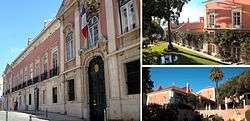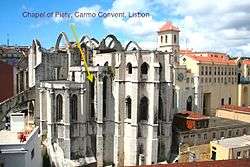Filipa Moniz Perestrelo
| Filipa Moniz Perestrelo | |
|---|---|
| Born |
c. 1455 Porto Santo Island, Madeira, Portugal |
| Died | c. 1484 (aged 28–29) |
| Nationality | Portuguese |
| Known for | wife of Christopher Columbus |
| Spouse(s) | Christopher Columbus (1479) |
| Children | Diego Columbus |
| Parent(s) |
Bartolomeu Perestrelo Isabel Moniz |


Filipa Moniz Perestrelo (c. 1455 – c. 1484) was a Portuguese noblewoman from Porto Santo Island, in Madeira, Portugal. She was the wife of Christopher Columbus, married in 1479 in Vila Baleira on the island.
History
Filipa Moniz was the daughter of Isabel Moniz and Bartolomeu Perestrelo.[1] Prior to marrying she was one of the twelve elite Comendadoras of the Monastery of All Saints in Lisbon of the Military Order of St. James, which means she had a comendary.[2] Her step son Ferdinand Columbus and her brother - in -law Bartholomew Columbus, described her as a "noble Comendadora" residing in the Monastery of All Saints.[3]
Marriage
Discussing the question how Christopher Columbus, the son of a Genoese wool weaver, could marry the daughter of a Portuguese Knight of Santiago, member of the household of Prince John, Lord of Reguengos de Monsaraz (Master of Santiago,) and of Prince Henry the Navigator's household, Samuel Eliot Morison[4] wrote that this is "no great mystery." Filipa was "already about 25 years old," her mother was a widow "with slender means," and "her mother was glad enough to have no more convent bills to pay, and a son-in-law [...] who asked for no dowry."
Another view is presented by Portuguese professor Joel Silva Ferreira Mata, who researched All-Saints and its residents,[5] showed that as "member" of the Order of Santiago, in order for Filipa to marry the future Admiral Columbus, she, like all members, required authorization from Santiago's Master,[6] because, like all other religious and military orders, the Order of Santiago had its established rules and protocols by which it was governed.[7] The Master of Santiago from 1470 to 1492, thus governing at the time of Filipa's marriage, was King John II of Portugal. From this marriage was born Diego Columbus in 1479 or 1480 who went on to become 2nd Admiral of the Indies, 2nd Viceroy of the Indies and 3rd Governor of the Indies and who married King Fernando's cousin, María de Toledo y Rojas. Thus Filipa Moniz was daughter of a King's Captain, wife of a Viceroy and mother of another Viceroy.
Columbus had a second son, Fernando, from Beatriz Enriquez de Arana, after Filipa died, in 1488.
Interment
Filipa died in 1485. The cause of her death was murder. She was buried in the Capela da Piedade (Chapel of Piety), which is the first chapel to the right of the main chapel in the Carmo Convent along with her sister, Izeu Perestrelo and her brother-in-law, Pedro Correia da Cunha.
See also
- People from Madeira
- Rafael Perestrello, a cousin of Filipa Perestrelo who was among the first Europeans to land in China (via the South China Sea) during the Chinese Ming Dynasty
References
- ↑ Freitas, Antonio Maria de (1893). The Wife of Columbus: With Genealogical Tree of the Perestrello and Moniz Families. New York: Stettinger, Lambert & Co.
- ↑ A district or a manor with lands and tenements appertaining thereto, under the control of a member of an order of knights who was called a commander; - called also a preceptory. http://www.thefreedictionary.com/Commandery
- ↑ Historie del S. D. Fernando Colombo; nelle quali s'ha particolare, & vera relatione della vita, & de fatti dell'Ammiraglio D. Cristoforo Colombo, suo padre: Et dello scoprimento ch'egli fece dell'Indie Occidentali, dette Mondo Nuovo (The life of the Admiral Christopher Columbus by his son Ferdinand)
- ↑ Samuel Eliot Morison, Admiral of the Ocean Sea pp. 37-39
- ↑ A Comunidade Feminina da Ordem de Santiago: A comenda de Santos na Idade Média, Prof. Joel Silva Ferreira Mata, Universidad Lusíada, Oporto, 1992.
- ↑ http://www.cepese.pt/portal/investigacao/publicacoes/Militarium_9.pdf
- ↑ MATA, Joel Silva Ferreira – A comunidade feminina da Ordem de Santiago: a comenda de Santos em finais do século XV e no século XVI. Um estudo religioso, económico e social. In Militarium Ordinum Analecta. Porto, No. 9, Fundação Engenheiro António de Almeida, 2007.